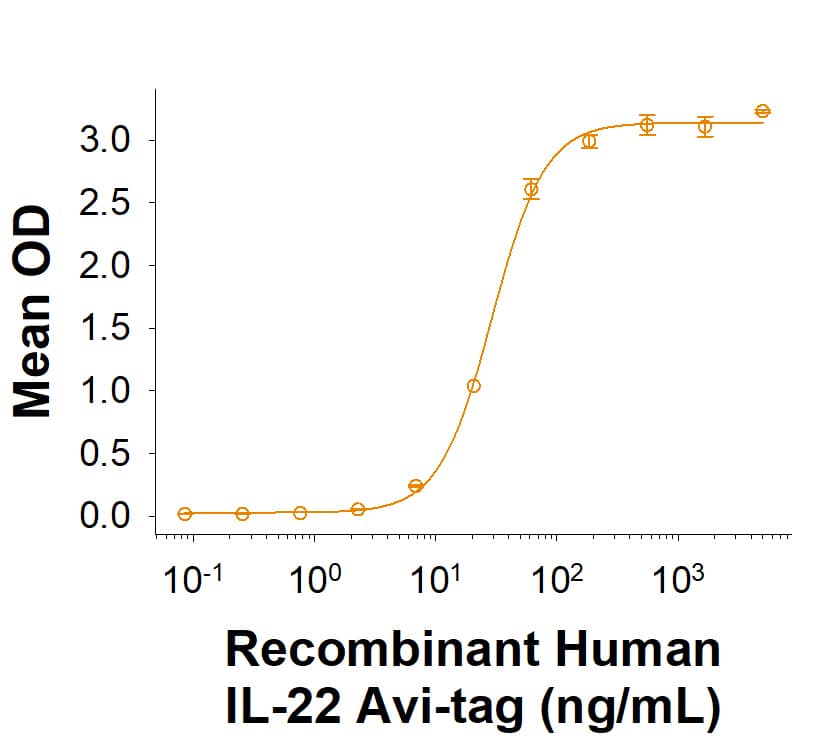Recombinant Human IL-22 Avi (HEK293-expressed) Protein, CF
R&D Systems, part of Bio-Techne | Catalog # AVI11311

Key Product Details
Source
Accession #
Structure / Form
Conjugate
Applications
Product Specifications
Source
| GG | Avi-tag | Human IL-22 (Ala34-Ile179) Accession # Q9GZX6.1 |
| N-terminus | C-terminus |
Purity
Endotoxin Level
N-terminal Sequence Analysis
Predicted Molecular Mass
SDS-PAGE
Activity
Recombinant Human IL-22 Avi-tag (Catalog # AVI11311) binds Recombinant Human IL-22BP (Catalog # 8498-BP/CF) with an ED50 of 10.0-120 ng/mL.
Scientific Data Images for Recombinant Human IL-22 Avi (HEK293-expressed) Protein, CF
Recombinant Human IL‑22 Avi-tag Protein Binding Activity.
Recombinant Human IL‑22 Avi-tag Protein (Catalog # AVI11311) binds Recombinant Human IL-22BP (8498-BP/CF) with an ED50 of 10.0-120 ng/mL.Recombinant Human IL‑22 Avi-tag Protein SDS-PAGE.
2 μg/lane of Recombinant Human IL‑22 Avi-tag Protein (Catalog # AVI11311) was resolved with SDS-PAGE under reducing (R) and non-reducing (NR) conditions and visualized by Coomassie® Blue staining, showing bands at 25-31 kDa, under reducing conditions.Formulation, Preparation and Storage
AVI11311
| Formulation | Lyophilized from a 0.2 μm filtered solution in PBS. |
| Reconstitution | Reconstitute at 250 μg/mL in PBS. |
| Shipping | The product is shipped at ambient temperature. Upon receipt, store it immediately at the temperature recommended below. |
| Stability & Storage | Use a manual defrost freezer and avoid repeated freeze-thaw cycles.
|
Background: IL-22
Interleukin-22 (IL-22), also known as IL-10-related T cell-derived inducible factor (IL-TIF) was initially identified as a gene induced by IL-9 in mouse T cells and mast cells. Human IL-22 cDNA encodes a 179 amino acid (aa) residue protein with a putative 33 aa signal peptide that is cleaved to generate a 147 aa mature protein that shares approximately 79% and 22% aa sequence identity with mouse IL-22 and human IL-10, respectively. The human IL-22 gene is localized to chromosome 12q15. Although it exists as a single copy gene in human and in many mouse strains, the mouse IL-22 gene is duplicated in some mouse strains including C57B1/6, FVB and 129. The two mouse genes designated IL-TIF alpha and IL-TIF beta, share greater than 98% sequence homology in their coding region. IL-22 has been shown to activate STAT‑1 and STAT-3 in several hepatoma cell lines and upregulate the production of acute phase proteins. IL-22 is produced by normal T cells upon anti-CD3 stimulation in humans. Mouse IL-22 expression is also induced in various organs upon lipopolysaccharide injection, suggesting that IL-22 may be involved in inflammatory responses. The functional IL-22 receptor complex consists of two receptor subunits, IL-22R (previously an orphan receptor named CRF2-9) and IL-10R beta (previously known as CRF2-4), belonging to the class II cytokine receptor family. Our Avi-tag Biotinylated human IL-22 features biotinylation at a single site contained within the Avi-tag, a unique 15 amino acid peptide. Protein orientation will be uniform when bound to streptavidin-coated surface due to the precise control of biotinylation and the rest of the protein is unchanged so there is no interference in the protein's bioactivity.
References
- Dumoutier, L. et al. (2000) J. Immunol. 164:1814.
- Xie, M-H. et al. (2000) J. Biol. Chem. 275:31335.
- Dumoutier, L. et al. (2000) PNAS 97:10144.
- Kotenko, S.V. et al. (2001) J. Biol. Chem. 276:2725.
Long Name
Alternate Names
Gene Symbol
UniProt
Additional IL-22 Products
Product Documents for Recombinant Human IL-22 Avi (HEK293-expressed) Protein, CF
Product Specific Notices for Recombinant Human IL-22 Avi (HEK293-expressed) Protein, CF
For research use only

